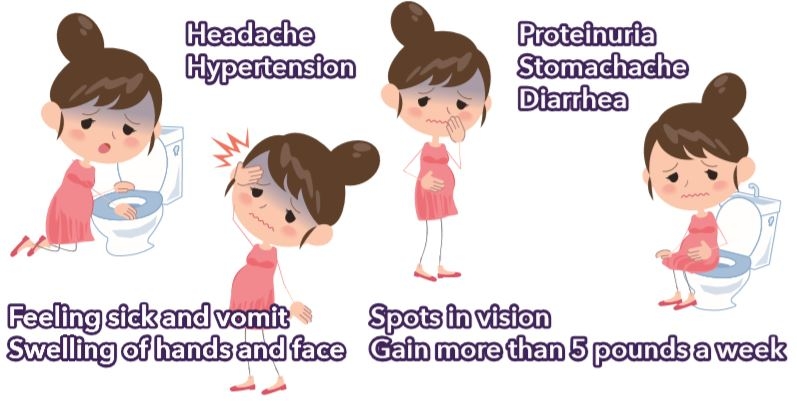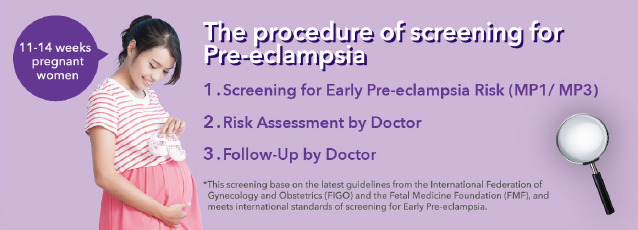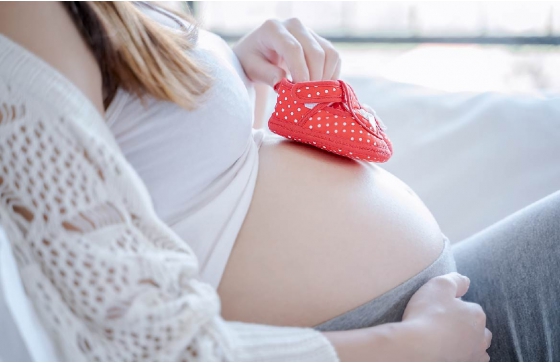DiagRIGHT®Pre-Eclampsia Risk Assessment (MP1/2/3/X)Back
Pre-eclampsia is more common than Down syndrome’, studies have shown that 1 in 13 pregnant women is affected by Pre-eclampsia
What is Pre-eclampsia ?
Pre-eclampsia, also known as Pregnancy Toxemia, is a very serious pregnancy complication. It is a silent killer for pregnant women in recent years. If a pregnant woman suffers from toxemia of pregnancy, the placenta might not be able to provide sufficient blood to the fetus, resulting in serious health problem for both the mother and the fetus with possibility of fatality.
Pose a serious threat to the lives of the pregnant mom and the fetus
- More than 2,500,000 fetuses* are born prematurely each year due to Pre-eclampsia
- 500,000 fetuses* die from Pre-eclampsia in the whole world every year and the heart problems triggered by this condition
- 76,000 pregnant women* worldwide die every year from Pre-eclampsia and the hypertension triggered by this condition
*Kuklina EV, et al. Hypertensive disorders and severe obstetric morbidity in the United States. Obstet Gynecol 2009; 113:1299-306
Common symptoms of Pre-eclampsia:

- Feeling sick and vomit
- Swelling of hands and face
- Headache
- Hypertension
- Spots in vision
- Gain more than 5 pounds a week
- Proteinuria
- Stomachache
- Diarrhea
The procedure of screening for Pre-eclampsia

- Screening for Early Pre-eclampsia Risk (MP1/ MP3)
- Risk Assessment by Doctor
- Follow-Up by Doctor

Pre-eclampsia is more common than Down syndrome’, studies have shown that 1 in 13 pregnant women is affected by Pre-eclampsia
What is Pre-eclampsia ?
Pre-eclampsia, also known as Pregnancy Toxemia, is a very serious pregnancy complication. It is a silent killer for pregnant women in recent years. If a pregnant woman suffers from toxemia of pregnancy, the placenta might not be able to provide sufficient blood to the fetus, resulting in serious health problem for both the mother and the fetus with possibility of fatality.
Pose a serious threat to the lives of the pregnant mom and the fetus
- More than 2,500,000 fetuses* are born prematurely each year due to Pre-eclampsia
- 500,000 fetuses* die from Pre-eclampsia in the whole world every year and the heart problems triggered by this condition
- 76,000 pregnant women* worldwide die every year from Pre-eclampsia and the hypertension triggered by this condition
*Kuklina EV, et al. Hypertensive disorders and severe obstetric morbidity in the United States. Obstet Gynecol 2009; 113:1299-306
Common symptoms of Pre-eclampsia:

- Feeling sick and vomit
- Swelling of hands and face
- Headache
- Hypertension
- Spots in vision
- Gain more than 5 pounds a week
- Proteinuria
- Stomachache
- Diarrhea
The procedure of screening for Pre-eclampsia

- Screening for Early Pre-eclampsia Risk (MP1/ MP3)
- Risk Assessment by Doctor
- Follow-Up by Doctor
Service Procedure Q&A
Service Procedure
PART 1 : Contact your obstetrician or medical center
PART 2 : Go to the clinic for testing services and tell the doctor to send the samples to Diagcor Laboratory
PART 3 : Get report
After one or two working days, the clinic will contact the client for a report.
If you need to interpret the report, please contact the clinic (blood drawing clinic).
Q&A
QWhy choose this Pre-eclampsia screening?
This screening meets the international standards for early pre-eclampsia (refer
to the latest guidelines of FIGO and FMF), and can accurately predict the risk of
developing pregnancy toxemia.
QWhen is it appropriate to do this test?
It is especially recommended for pregnant women from the 11th to the 14th week of pregnancy to test. If you can be found as a high-risk pregnant woman before the 14th week, you can seize the golden time of treatment and reduce the premature birth rate by up to 80%.
QWhat does the report mean as low or high risk?
If risk is low, it means that you are less likely to develop pregnancy toxemia during pregnancy. Conversely, if you have a high risk means that the chances of developing the disease during pregnancy are quite high. Doctors can start the intervention earlier and monitor pregnancy more closely to reduce the impact of the disease to the mother and the fetus.
QIf you have had pregnancy toxemia during pregnancy, is there a high chance of having it again in the future?
Women who have suffered from pregnancy toxemia during pregnancy in the
past have higher chances of developing it again in any subsequent pregnancy. But because of individual differences, early pre-eclampsia screening is recommended for every pregnancy in between 11- and 14-week.
QWill there be any aftereffect to pre-eclampsia?
Studies show that pregnant women with pregnancy toxemia are twice as likely to also have cardiovascular disease and hypertension than other mothers. Premature babies generally have poor resistance and immunity, which can lead to stunting.
QCan I do this test if I am beyond 14 weeks pregnant?
It is recommended that you check with your doctor first. For pregnancy on or
after 20 weeks we can also provide screening (MP2) and/or a short-term prediction
(MPX). The report will be available within one working day.



